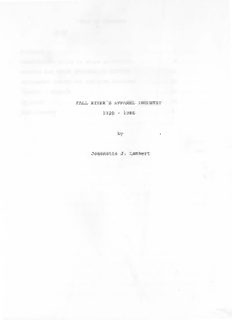
FALL RIVER'S APPAREL INDUSTRY 1920 PDF
Preview FALL RIVER'S APPAREL INDUSTRY 1920
FALL RIVER'S APPAREL INDUSTYR 1920 - 198 6 by Jeannette J . Lambert TABLE OF CONTENTS FOREWORD 1 TRANSITIONS : Mills to Shops to Outlets 8 WORKERS AND THEIR STRUGGLE TO SURVIVE 2 1 GOVERNMENT GRANTS AND TRAINING PROGRAMS 2 9 IMPORTS - EXPORTS 3 9 EPILOGUE 4 6 BIBLIOGRAPHY 47 FOREWORD The city of "Troy", the "Spindle City", and the city o f "Fall River" are all one and the same . The name has changed as times changed, but life in the "Spindle City" will always be on e of productivity . Throughout the history of Fall River, its work force has had to adapt as often as the city's name has changed . Transitions have taken place even in this city as the mills bega n to close their doors and "sweatshops" came into being . Even now , "sweatshops" have changed into plants and factories . Now some of these buildings have transformed into retail outlets . In the 1800s and early 1900s, young immigrant and nativ e farm girls left their homes to live and share rooms in apartmen t buildings owned and operated by mill owners . These young girl s lived and worked under horrendous conditions . They would work an average of fourteen to sixteen hours a day for very little pay . Room and board would be deducted from their pay . In the twentie s and thirties the apparel industry began its endeavors . People banded together to improve conditions ; hence the unions were abl e to stabilize and were able to achieve a better environment fo r the people of this productive city . After World War II, the need to educate people became quit e evident . People needed to be trained for various jobs and thes e training programs needed to be funded . The city needed workers , and people needed the state and federal government to hel . As a result, p subsidize various training programs management, government, and the community had to look to eac h other for support in the industry . A major problem of the needle trade industry is the import quota. At one time, we were the wealthiest country in imports and exports ; but times change and now we are at the bottom of th e ladder . Currently, our largest export is scrap metal and paper trash . We export approximately 2% of our textiles . Our trade deficit leaves a lot to be desired considering we are supposed t o be a wealthy and productive nation . ACKNOWLEDGEMENTS : The following people have been a great help to me throug h guidance and encouragement ; so to these people goes a specia l thank-you : Sue Porter Benson, Joe Murphy, Ron Bettencourt, Eddie Lambert Jr ., Ed Lambert Sr ., and all members of my family . Thank you . TRANSITIONS : Mills to Shops to Outlets to Pho Journal-Bulletin CITY HISTORY : Part of the former Richard Borden Mills complex in pre-fire photo of 1979. Between the years 1905 and 1921, mills boomed in the Fal l River area . More than one hundred mills, housing four millio n spindles, gave thirty thousand people employment and there was a weekly payroll in excess of one million dollars . Yet, what took one hundred years to build crumbled in less than a decade . Some 8
Description: